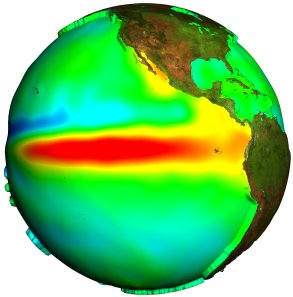Climate
The ocean covers 71% of Earth surface, and plays a major role in climate change and thermal regulation. It is permanently in motion, and exchanges large quantities of heat with the atmosphere. The ocean takes in heat from the strong sunshine of the Tropics, and moves it to higher latitudes along major ocean currents such as the Gulf Stream. The warm tropical waters heat the atmosphere. At the poles, on the contrary, cold waters move in deep currents towards the Equator, where they are heated and move back towards the poles. And so the cycle goes on. Winds are closely linked to high and low pressures in the atmosphere, themselves modified by ocean-atmosphere heat exchanges.
From the seasonal to the decadal, or even the centennial timeframe, the ocean's influence upon the atmosphere is one of the keys to climate forecasting, including events such as El Niño.
Altimetry is one of the most important tools for monitoring ocean dynamics, and as such is a source of vital data for including in forecasting models of ocean-atmosphere coupled events such as El Niño, monsoons, the North Atlantic Oscillation or decadal oscillations. Seasonal climate forecasting is also beginning to show interesting results. The oceans are in turn affected by climate variations, as the sea level rises and falls in response to their fluctuations.





